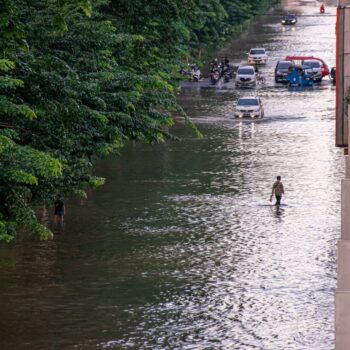Europe’s security rests on its neighbours’ long-term stability. Yet as the immediate political focus lurches from one short-term crisis to the next, long-term priorities are neglected. To break out of this cycle, European leaders need to refocus on the root causes of instability and better understand the full economic and security value of future-oriented investment. The first step will be to put a new approach to energy and climate change in line with the Paris Agreement at the heart of the new European Global Strategy.
Five years ago, as the Arab Spring began in the streets of Tunis and Cairo, European leaders were fuelled by optimism towards democracy and political reforms across the Middle East and North Africa (MENA) region. They could not have imagined that popular and largely non-violent demonstrations would be followed by the degree of instability Europe faces today: civil wars in Syria and Yemen, the rise of the self-declared Islamic State of Iraq and the Levant, authoritarian rules in Egypt and Turkey, the collapse of central Government in Libya, and the unprecedented wave of migrants landing on the shores of Europe every week.
Since then, the mood of Europeans towards the MENA region has moved overwhelmingly towards a defensive stance. The main goal today is to limit damages and deliver quick wins against the rise of domestic anti-establishment populism. The biggest risk however is to fail to deliver long-term stability across the region, with even direr consequences for European security. This requires a much deeper understanding of the root causes of instability as well as identifying high-impact investments in future stability.
As the region just suffered the worst drought in 900 years (Figure 1), the potential for large-scale disruptions of food systems and potential conflicts over water resources dramatically increases. One of the main drivers of instability in the MENA region has been a decline in living conditions driven by increased food and water insecurity. The region uses the equivalent of another Nile in “virtual water” each year embodied in food imports [PDF – 3.2MB], as most Arab countries import half of their food supplies. This makes them acutely vulnerable to external drivers of instability, such as volatility in global prices.
Figure 1: The Levant region suffering the worst drought (1998-2012) in 900 years
Source: NASA
It has been estimated that climate change made the extraordinary Russian heatwave of 2010 three times more likely, leading to a collapse of Russia’s wheat harvest and a sharp rise of the price of wheat on global markets. The record high food and oil prices in 2010, combined with the inability of government subsidies to absorb the price shocks, drove hundreds of thousands of people to the streets. Today, these fiscal pressures have been replaced by reduced budget revenues from low oil prices which increase the risk of popular unrests from social spending cuts.
These trends are likely to worsen over time: Major import crops, such as wheat, are likely to increase in price by up to 80% by 2030 due to growing global demand; climate change could increase prices by a further 40% (Figure 2).
Figure 2: Real food price changes predicted over the next 20 years
Source: Oxfam
There is no security without climate security
Climate change is responsible for the unprecedented run of extreme weather conditions which have fuelled many of the stresses underlying broader instability. Prior to the civil war in Syria, extreme drought conditions drove as many as 1.5 million people from the country's breadbasket region in the northeast to urban peripheries of the south. Temporary settlements, composed largely of displaced rural people, formed on the outskirts of Damascus, Hama, Homs, Aleppo, and Dara'a – the latter being the site of the first significant protest in March 2011. This migration flow exacerbated economic strains already caused by nearly 2 million refugees from neighbouring Iraq and Palestine.
If European leaders want to succeed in staving off disorder in the MENA region and preventing future mass displacement of people, they need to recognise the interlinkages between climate change, economic development, and security. Because the MENA region faces disproportionate challenges from climate change, investment and development strategies must directly address key vulnerabilities and focus on sustainable growth and jobs.
Delivering the Paris Agreement and the 17 Sustainable Development Goals (SDGs) will directly address these challenges as they require a fundamental shift of investment and diplomatic priorities. All European external support will need to be in line with the long-term goal and the countries’ climate and energy commitments under the Paris Agreement – known as the Intended Nationally Determined Contributions – as well as the SDGs. Refocusing priorities on resilient investment over decarbonisation and sustainable development will bring multiple security and economic dividends for both the MENA countries and European citizens and businesses.
If the current approach to energy investment continues, whereby access to fossil fuels is prioritised on the basis of outdated energy security fears, the risks of instability will increase. Fossil fuels infrastructure will risk locking in high carbon emissions and thus dangerous climate change while exposure to price volatility will deepen investment uncertainty and fiscal pressures. As Europe decarbonises its energy system, it will be less and less dependent on fossil fuels imports and infrastructure, and more on access to clean energy markets to stay prosperous.
In June 2016, European leaders will adopt a new European Global Strategy. This will be a key opportunity for the European Commission and Member States to work together to develop a broad framework for delivering long-lasting stability in the MENA region. This framework needs not only to look at short-term challenges but at the longer-term too. Putting the delivery of the Paris Agreement and the SDGs at the heart of the strategy will help Europe and its neighbours remaining safe and investing in future prosperity.
For further reading see:




